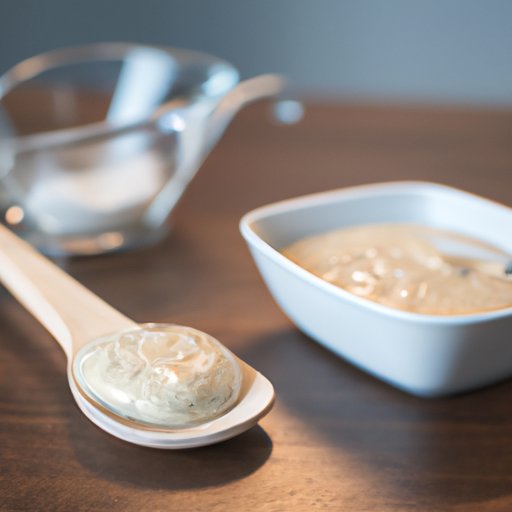
Introduction
Horseradish sauce is a classic condiment that adds flavor and kick to any dish. While it may seem intimidating to make, with a little guidance and practice, you can create a delicious, homemade horseradish sauce right in your own kitchen. In this article, we’ll cover everything you need to know to make horseradish sauce successfully, including alternative flavor twists, health benefits, pairing suggestions, and tips and tricks from the pros.
Step-by-Step Guide to Making Horseradish Sauce
Before we dive into the recipe, let’s first go over what you’ll need to make horseradish sauce:
- A fresh horseradish root
- Vinegar
- Salt
- Sugar (optional)
- Food processor or grater
- Glass jar with a lid for storage
Now that you have your ingredients and tools, let’s get started with the step-by-step instructions:
- Wash and peel the horseradish root. Cut it into small chunks so that it can fit in the food processor.
- Pulse the horseradish root in the food processor until it is finely grated. Be careful not to over-process the horseradish as it can become bitter.
- Transfer the grated horseradish to a small bowl. Add vinegar and salt to taste. If desired, you can also add a pinch of sugar to balance out the flavors.
- Mix the ingredients together until well-combined. Taste and adjust the seasoning if needed.
- Transfer the horseradish sauce to a clean glass jar with a tightly-fitting lid. Store it in the refrigerator for up to two weeks.
If you find that your horseradish sauce is too pungent or spicy, you can mellow it out by adding a little bit of cream or sour cream to the mixture. This will also give the sauce a creamier texture.
Now that you know the basics, let’s troubleshoot some common issues that people have when making horseradish sauce.
Troubleshooting Common Problems
One common problem people encounter when making horseradish sauce is that it can be too bitter or spicy. To avoid this, be aware of how long you are processing the horseradish in the food processor and be sure to adjust the seasoning to your taste. Additionally, adding a little bit of cream or sour cream to the mixture can help balance out the flavors.
Another issue that may arise is that your horseradish sauce can become watery. This can happen if you add too much vinegar or if you do not properly drain excess water from the grated horseradish. Be sure to squeeze out all the excess water from the horseradish before mixing it with the vinegar and salt.
Alternative Flavor Twists on Horseradish Sauce
While traditional horseradish sauce is delicious on its own, there are many different flavor twists that you can try to enhance the taste and aroma of the sauce. Here are a few unique ideas:
- Honey Horseradish Sauce: Add a tablespoon of honey to the horseradish sauce mixture to create a sweet and spicy balance.
- Mustard Horseradish Sauce: Mix in a few tablespoons of your favorite mustard to the horseradish sauce to give it a tangy and zesty flavor.
- Herb Horseradish Sauce: Chop up some fresh herbs, such as parsley or chives, and mix them into the horseradish sauce to add a fresh and herby taste.
Don’t be afraid to get creative with your flavor twists. Experiment with different combinations until you find the perfect sauce for your taste buds.
Health Benefits of Horseradish Root
Not only is horseradish sauce a tasty addition to your meals, but horseradish root also offers many health benefits. Some of these benefits include:
- Aids in digestion: Horseradish has natural enzymes that aid in digestion and can help soothe an upset stomach.
- Boosts immunity: The high levels of vitamin C in horseradish root can help boost your immune system and protect against illness.
- Reduces inflammation: Horseradish contains compounds that can help reduce inflammation in the body and alleviate pain.
Incorporating horseradish root into your meals can be a beneficial addition to your overall health and wellbeing. Now, let’s talk about some foods that pair well with horseradish sauce.
Pairing Suggestions for Horseradish Sauce
Horseradish sauce complements and enhances the flavors of many different types of foods. Here are a few pairing suggestions to get you started:
- Roast Beef: Horseradish sauce is a classic pairing with roast beef. Spread it on your sandwich or enjoy it as a dipping sauce.
- Salmon: Add a dollop of horseradish sauce to your grilled or baked salmon for a flavorful twist.
- Veggies: Use horseradish sauce as a dip for vegetables, such as carrots or celery.
Don’t be afraid to experiment with different pairings to find your favorite combinations. Let your taste buds be your guide.
Tips and Tricks for Making Horseradish Sauce
Now that you have all the information you need to make horseradish sauce, here are a few tips and tricks to help you along the way:
- Grate the horseradish root right before making the sauce to ensure maximum freshness and flavor.
- Be careful not to over-process the horseradish in the food processor as it can become bitter. Pulsing it in short bursts is the key to achieving the right consistency.
- Balance out the flavors of the horseradish sauce by adding a little bit of sugar or cream to the mixture.
- Store the horseradish sauce in a glass jar with a tightly-fitting lid in the refrigerator for up to two weeks.
With practice and patience, you’ll be able to confidently whip up your own batch of horseradish sauce that is perfectly tailored to your tastes.
Conclusion
Creating your own horseradish sauce is easier than you think and can have many benefits, such as improved health and a more flavorful meal. By following our step-by-step guide, experimenting with flavor twists, and pairing the sauce with different foods, you’ll be able to create the perfect sauce for any dish.




